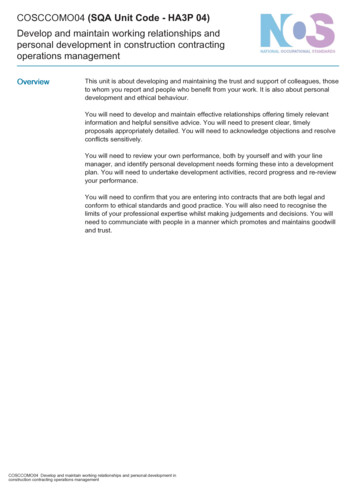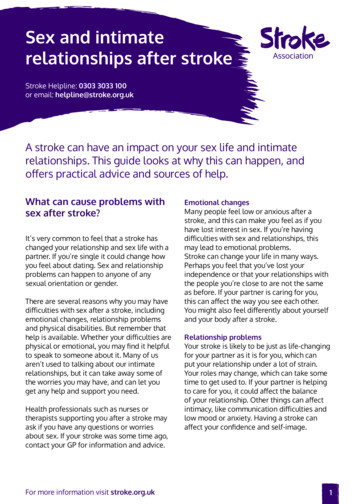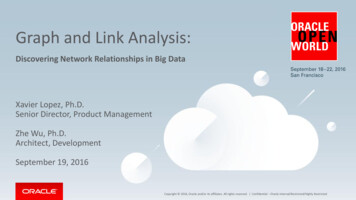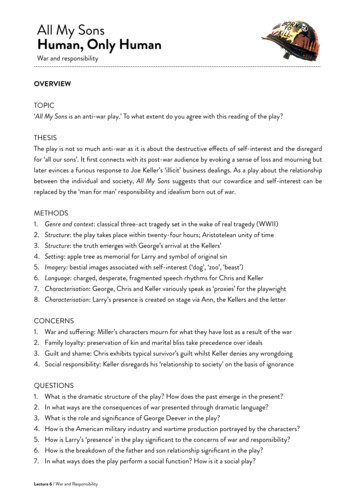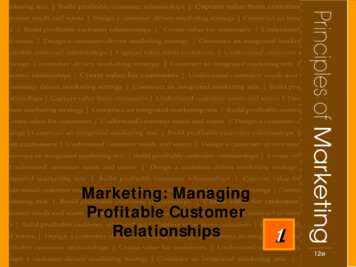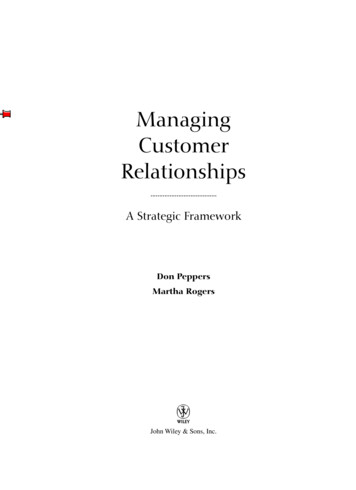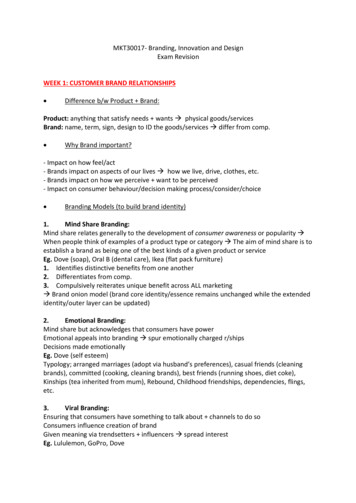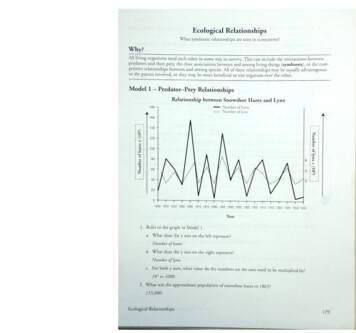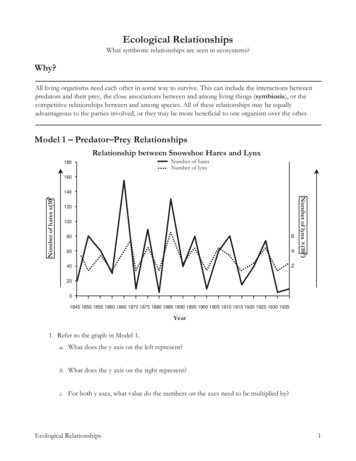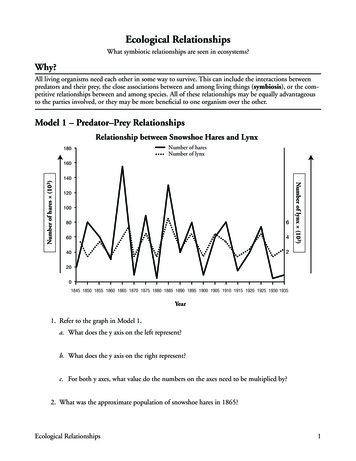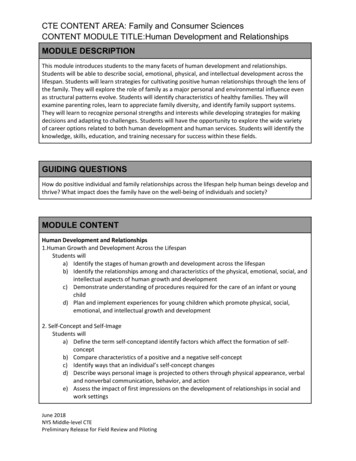
Transcription
CTE CONTENT AREA: Family and Consumer SciencesCONTENT MODULE TITLE:Human Development and RelationshipsMODULE DESCRIPTIONThis module introduces students to the many facets of human development and relationships.Students will be able to describe social, emotional, physical, and intellectual development across thelifespan. Students will learn strategies for cultivating positive human relationships through the lens ofthe family. They will explore the role of family as a major personal and environmental influence evenas structural patterns evolve. Students will identify characteristics of healthy families. They willexamine parenting roles, learn to appreciate family diversity, and identify family support systems.They will learn to recognize personal strengths and interests while developing strategies for makingdecisions and adapting to challenges. Students will have the opportunity to explore the wide varietyof career options related to both human development and human services. Students will identify theknowledge, skills, education, and training necessary for success within these fields.GUIDING QUESTIONSHow do positive individual and family relationships across the lifespan help human beings develop andthrive? What impact does the family have on the well-being of individuals and society?MODULE CONTENTHuman Development and Relationships1.Human Growth and Development Across the LifespanStudents willa) Identify the stages of human growth and development across the lifespanb) Identify the relationships among and characteristics of the physical, emotional, social, andintellectual aspects of human growth and developmentc) Demonstrate understanding of procedures required for the care of an infant or youngchildd) Plan and implement experiences for young children which promote physical, social,emotional, and intellectual growth and development2. Self-Concept and Self-ImageStudents willa) Define the term self-conceptand identify factors which affect the formation of selfconceptb) Compare characteristics of a positive and a negative self-conceptc) Identify ways that an individual’s self-concept changesd) Describe ways personal image is projected to others through physical appearance, verbaland nonverbal communication, behavior, and actione) Assess the impact of first impressions on the development of relationships in social andwork settingsJune 2018NYS Middle-level CTEPreliminary Release for Field Review and Piloting
3. Peer Influence and Stress ManagementStudents willa) Define the terms “pee” and “peer pressure”b) Compare the influence of family, peers, media, and others on decision-makingc) Analyze positive and negative aspects of peer pressure and ways to assert individualchoices within a peer groupd) Recognize that adolescents experience common problemse) Identify the causes of stress and examine appropriate ways to manage stressors4. Human RelationshipsStudents willa) Identify characteristics of healthy human relationshipsb) Identify characteristics of unhealthy human relationshipsc) Discuss strategies for strengthening human relationships5. Family Role in SocietyStudents willa) Evaluate the significance of family and its impact on the well-being of individuals andsocietyb) Examine “family” as the basic unit of societyc) Investigate family structures and transitionsd) Examine the role of the family in teaching cultural traditions and understanding of culturaldiversitye) Discuss ways family influence can nurture or impede the development of an adolescent’sself-concept, personality, and emerging independencef) Identify support groups, agencies, and community organizations which assist the family incarrying out its basic functions7. ParentingStudents willa) Evaluate the impact of parenting roles and responsibilities on strengthening the wellbeing of individuals and familiesb) Identify roles and responsibilities of parentingc) Analyze physical, social, and emotional factors related to readiness for parenting8. Career PathwaysStudents willa) Investigate a career in human development orhuman services field and identify thepathways used to reach that careerb) Assess personal knowledge, skills, and interest in careers in human developmentandhuman servicesand evaluate personal suitability for these careersILLUSTRATIVE ACTIVITIES by Theme ModuleCareer and Community ConnectionsJune 2018NYS Middle-level CTEPreliminary Release for Field Review and Piloting
Activities for Afterschool ProgramSmall groups of students create developmentally appropriate activity plans foran elementaryafterschool program. Students assist in the afterschool program through the presentation oftheir activity. Students discern the types of development their activity was designed topromote in the younger students and evaluate the results.Communication and Interpersonal RelationshipsHealthy and Unhealthy RelationshipsStudents view video clips displaying characteristics of unhealthy human relationships such as:criticism, contempt, defensiveness, stonewalling,and dishonesty. Students brainstormstrategies that might strengthen the relationship depicted in the video, such as: “I”statements, appreciation, gratitude, seeking understanding, and taking responsibility.Students recreate the video clips showing characteristics of healthy human relationshipssuchas:respect, boundaries, accountability, integrity, compromise, problem-solving, andgenerosity.Financial and Consumer LiteracyFamily BudgetProvide students with a monthly budget for a family with young children who are moving intothe community. Have students research childcare options available and the costs and featuresof each. Students present findings on local childcare providers and discuss strategies forincluding childcare in the family budget and adjust the monthly budget to account for typicallocal childcare costs.Health, Safety, and WellnessMindfulness JournalStudents learn and practice mindfulness exercises in class. Challenge students to implementmindfulness in their other classes, or whenever they face a stressor. Have students keep amindfulness journal with responses to various prompts about stress, peer pressure, gratitude,and mindset. Students select two entries to share and discuss with the with class.Problem Solving and InnovationPrototype ToysSet up a display of children's toys in the classroom. Have students identify safety hazards andtoys that are inappropriate for a particular developmental stage. Small groups of students willdesign and create prototypes of toys that correct the safety or developmental issuesassociated with toys from the original display. Have students test the prototypes withchildren.SustainabilityMischel's Marshmallow ExperimentIntroduce students to the Stanford marshmallow (Mischel) test by replicating the experimentin class. Lead a discussion on the struggles students, and most humans, have with delayinggratification. Provide students with short articles on current social and environmental issueswhich require long-term solutions. Ask students to describe how the concept of delayedgratification impacts sustainable solutions for these issues.June 2018NYS Middle-level CTEPreliminary Release for Field Review and Piloting
STANDARDS ADDRESSEDNew York State Career Development and Occupational Studies (CDOS) StandardsIntermediate Levelhttp://www.p12.nysed.gov/cte/Standard 1: Career DevelopmentStudents will be knowledgeable about the world of work, explore career options, andrelate personal skills, aptitudes, and abilities to future career decisionsStandard 2: Integrated LearningStudents will demonstrate how academic knowledge and skills are applied in theworkplace and other settingsStandards 3a: Universal Foundation SkillsStudents will demonstrate mastery of the foundation skills and competenciesessential for success in the workplaceNYS Learning Standards for Family and Consumer SciencesIntermediate Levelhttp://www.p12.nysed.gov/cte/Standard 2: Safe and Healthy EnvironmentStudents will acquire the knowledge and ability necessary to create and maintain asafe and healthy environmentCommon Career Technical Core racticesCareer Ready Practices3. Attend to personal health and financial well-being4. Communicate clearly and effectively and with reason5. Consider environmental, social, and economic impacts of decisions9. Model integrity, ethical leadership, and effective management12. Work productively in teams while using cultural global competenceCluster StandardsHuman Services Career Cluster 2. Evaluate the role of the family, community, and human services in society and theeconomy5. Evaluate career opportunities in each of the Human Services Career Pathways6. Explain how human development principles enhance the well-being of individuals andfamiliesEarly Childhood Development and Services Career Pathway1. Demonstrate communication techniques with children to facilitate ongoing developmentand enhance learning2. Communicate effectively with fellow staff members to facilitate child developmentactivities7. Apply principles of child growth and development, including social, emotional, physical,and cognitive milestones to provide comprehensive program offerings8. Evaluate curriculum for inclusiveness of children with special needsJune 2018NYS Middle-level CTEPreliminary Release for Field Review and Piloting
Family and CommunityServicesCareerPathway2. Identify community resources to provide family and community servicesNational Family and Consumer Sciences ds-and-competencies.html6.0 FamilyEvaluate the significance of family and its effects on the well-being of individuals and society.6.1Analyze the effects of family as a system on individuals and society6.2Evaluate the effects of diverse perspectives, needs, and characteristics ofindividuals and families15.0 ParentingEvaluate the effects of parenting roles and responsibilities on strengthening the well-being ofindividuals and families15.1 Analyze roles and responsibilities of parenting15.2 Evaluate parenting practices that maximize human growth and developmentRESOURCESUS Department of Health and Human ServicesAdministration for Children and Familieshttps://www.acf.hhs.gov/The Administration for Children and Families (ACF) is a division of the Department ofHealth and Human Services. ACF promotes the economic and social well-being ofchildren, families, individuals and communities with leadership and resources forcompassionate, effective delivery of human services. ACF’s Office of Planning,Research and Evaluation studies ACF programs and the populations they servethrough rigorous research and evaluation projects.U.S. Cooperative Extension //articles.extension.org/family caregivingThe U.S. Cooperative Extension System’s mission is to address issues of importance tothe nation through fostering creativity and innovation in developing solutions andmethods of work and advancing the visible and measurable impact of their work forthe public good.American Academy of Pages/default.aspxThis website includes research-driven links about wide-ranging topics such as Agesand Stages, Healthy Living, Safety and Prevention, Family Life, and Health issues.New York State Office of Mental HealthJune 2018NYS Middle-level CTEPreliminary Release for Field Review and Piloting
https://www.omh.ny.gov/omhweb/childservice/The Office of Mental Health (OMH) regulates, certifies and oversees more than 4,500programs, which are operated by local governments and nonprofit agencies. Theseprograms include various inpatient and outpatient programs, emergency, communitysupport, residential and family care vidence cioeconomicstatustoachievementandwell-being. ated. CharacterlLab exists to aracter.Association of Career and Technical EducationCareer Planning /2018/02/ACTE CC Paper FINAL.pdfResearch has identified middle school as a time when students can benefit the mostfrom career exploration, a process of building self-awareness, learning aboutpotential careers, and developing a plan for reaching future goals.AdvanceCTEMiddle Level Career Interest files/StudentInterestSurvey-English.pdfProvides a Career Interest inventory worksheet to use with students in helping themidentify the potential matches to the sixteen career clusters available to them.Association of CTE Administrators (ACTEA)CTE Strong Videoshttp://www.ctestrong.comEdge Factor has created a series of inspirational videos related to Career andTechnical Education that provide students with a very contemporary perspective onCTE options. Career Cluster videos provide a new look at the many career options thatstudents have in high school and beyond.New York State Association of Family and Consumer Sciences Educators (NYSAFCSE)http://www.nysafcse.org/Family and Consumer Sciences education in New York State is delivered through avariety of courses designed to promote student attainment of the intermediate andcommencement level New York State Learning Standards for Family and ConsumerSciences (FACS) and Career Development and Occupational Studies (CDOS). Thisprofessional organization hosts a website that includes "Curriculum" and a "BestPractices" tabs.Career and Technical Education Technical Assistance Center of New York (CTE TAC)http://nyctecenter.org/The Career and Technical Education Technical Assistance Center (CTE TAC) operatesunder a state contract to assist the New York State Education Department (NYSED) inJune 2018NYS Middle-level CTEPreliminary Release for Field Review and Piloting
carrying out its mission of improving the quality, access, and delivery of career andtechnical education through research-based methods and strategies resulting inbroader CTE opportunities for all students.June 2018NYS Middle-level CTEPreliminary Release for Field Review and Piloting
Human Development and Relationships . 1.Human Growth and Development Across the Lifespan . Students will . a) Identify the stages of human growth and development across the lifespan b) Identify the relationships among and characteristics of the physical, emotional, social, and intellectual aspects of
